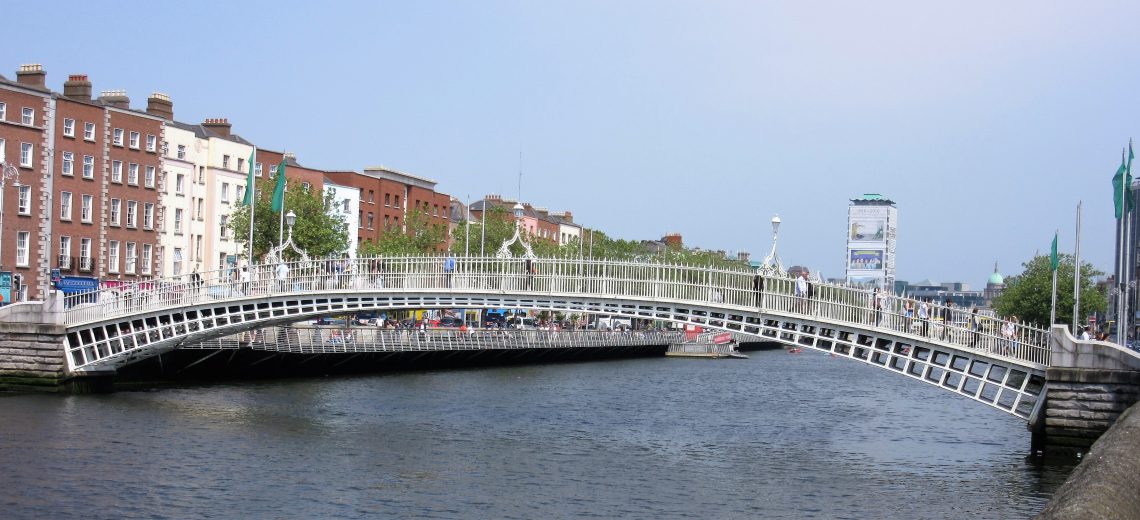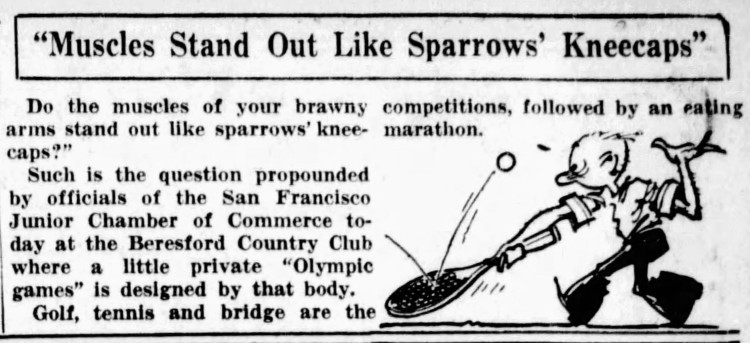The jocular phrase muscles like sparrows’ kneecaps and variants are used (self-)disparagingly of somebody’s physical strength—cf. footnote.
However, the earliest occurrence that I have found is puzzling; it is from the account by Kenneth Dyer of the annual training of the 230th Battery R.F.A. (= Royal Field Artillery) on Salisbury Plain—published in The Hastings and St Leonards Observer (Hastings, Sussex, England) of Saturday 15th July 1922:
If a Battery goes to camp without its full complement of men, difficulties arise. In one case, for instance, a section which should contain say twenty men, finds itself severely handicapped with less. This was unfortunately so this year. It was a real hardship, besides providing such awkward moments as when the Battery Commander cries out cheerily: “All correct Right Section?”
“All correct, sir,” replies the Section Commander. “He is here!”
To solve this difficulty we must advertise: “Wanted strong men who will join the Battery and come to camp. Must have chests like iron, hands and muscles as tough as sparrows kneecaps and all that sort of thing.”
The second-earliest occurrence that I have found is from the San Francisco Examiner (San Francisco, California, USA) of Friday 20th May 1932:
“Muscles Stand Out Like Sparrows’ Kneecaps”
Do the muscles of your brawny arms stand out like sparrows’ kneecaps?”
Such is the question propounded by officials of the San Francisco Junior Chamber of Commerce today at the Beresford Country Club where a little private “Olympic games” is designed by that body.
Golf, tennis and bridge are the competitions, followed by an eating marathon.
The above-quoted phrase the muscles of your brawny arms stand out like sparrows’ kneecaps is a parody of the muscles of his brawny arms are strong as iron bands, from The Village Blacksmith, by the U.S. poet Henry Wadsworth Longfellow (1807-1882). This is the beginning of this poem, as first published in the November 1840 issue of The Knickerbocker, or New-York Monthly Magazine (New York: William Osborn):
Under a spreading chestnut tree
The village smithy stands;
The smith, a mighty man is he,
With large and sinewy hands;
And the muscles of his brawny arms
Are strong as iron bands.
Finally, the following recipe is from The Gadabout’s Corner, by the columnist Toddy Beattie, published in The Vancouver Sun (Vancouver, British Columbia, Canada) of Saturday 11th Mar 1950:
Soup Bowl . . .
For the soup course, there are all kinds . . . vegetables, mushroom, onion, and the kind you get into, but here’s one guaranteed to put hair on the chest of the little man with the muscles that stick out like sparrows’ kneecaps (been trying to work that in for weeks). . . . It’s steeped in beer. . . . For six servings, recipe calls for “half a pound of whole wheat bread, slightly stale and half a pound of pumpernickel. . . . Soak them in five cups of water for at least 12 hours. . . . Put on to cook until bread is pasty. . . . Stir often. . . . Add four and a half cups of dark beer, six tablespoons of sugar, pinch of salt, a piece of stick cinnamon and a little grated lemon rind. . . . Cook a few minutes. . . . Take off the fire and stir in an egg yolk. . . . Serve with a blob of sour cream”—and turn green?
The only complimentary use of sparrow’s kneecap that I have found is from a portrait by Charles Gay of the U.S. dancer, stage actress and singer Lady Charles Cavendish (born Adele Marie Austerlitz – 1896-1981), published in The Bystander (London, England) of Tuesday 17th July 1934:
Wide-mouthed and laughing, with a turned-up nose and ankles as thin as a sparrow’s knee-cap, Adèle will always be the perfect soubrette.
Lady Charles Cavendish, by Sirra
The Bystander (London) of 17th July 1934:

Oddly enough, sparrows’ kneecaps has also been used in culinary contexts. For example, the following paragraph is from the column Notes by the Wayside, published in the Milngavie and Bearsden Herald and Dumbarton County Courier (Milngavie, Dunbartonshire, Scotland) of Friday 5th June 1931—bumbee is a Scottish form of bumblebee:
Following on the news that creamed elephants’ ears on toast are to form a dish on offer at the French Colonial Exhibition comes the news that during Milngavie’s Civic Week local caterers are to offer stewed sparrows’ kneecaps, bumbees’s ankles, chocolate-coloured ducks’ insteps.—“Evening News.”
Likewise, on Monday 16th August 1976, the Liverpool Echo (Liverpool, Merseyside, England) published this perplexing paragraph:
Secret Recipe
An invitation to sample a new delicacy of sparrows kneecaps has boosted membership at the new Ornithology Club at St. Saviour’s School, Ellesmere Port. Now the club, started by a group of 11-year-olds is heading for a membership of over 50. Teacher Miss Susan Moores, who helped start the club, is keeping the recipe for sparrows kneecaps a closely-guarded secret.
Note: Outwardly only, sparrows’ kneecaps is similar to expressions such as the cat’s whiskers, the bee’s knees and the frog’s eyebrows, which are or were used to denote an outstandingly good person or thing.

